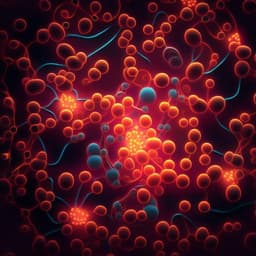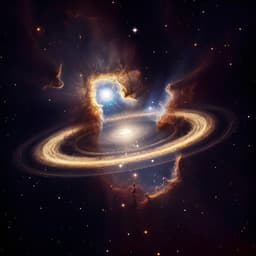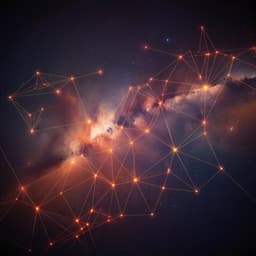
Physics
Experimental violation of n-locality in a star quantum network
D. Poderini, I. Agresti, et al.
This groundbreaking research reveals an experiment that defies conventional boundaries by demonstrating nonlocal correlations in star-shaped quantum networks. Conducted by a team including Davide Poderini and Iris Agresti, the findings promise new horizons for quantum information processing applications where the interplay of source independence and entanglement challenges classical models.
~3 min • Beginner • English
Introduction
Bell’s theorem shows the incompatibility of quantum predictions with local hidden variable (LHV) models and underpins device-independent (DI) applications such as quantum communication, cryptography, key distribution, and randomness generation. Most DI results concern bipartite Bell scenarios, while multipartite generalizations often rely on GHZ-type entangled states, which are experimentally demanding on photonic platforms. Near-term quantum networks are likely to be composed of multiple independent sources distributing small entangled pairs at higher quality and rates. Independence of sources in networks leads to richer correlations than standard Bell nonlocality, enabling nonlocality activation and novel non-classical behaviors. Experimentally, progress had been limited to the simplest network—the bilocality scenario—until recently. This work demonstrates scalability beyond bilocality by implementing up to four independent sources and five nodes in a star topology, and violating chained n-locality inequalities to witness nonlocal correlations in a DI manner under source independence assumptions.
Literature Review
Loophole-free violations of Bell inequalities have been achieved in several platforms, establishing DI nonlocality in bipartite scenarios. Theoretical developments extended nonlocality to networked configurations with independent sources (bilocality and n-locality), revealing activation phenomena, reduced detection-efficiency requirements, and new classes of correlations. Causal modeling via directed acyclic graphs (DAGs) has become a key tool to represent and analyze such networks. Prior experiments have demonstrated bilocality violations, including with complete and separable measurements, and more recently with truly independent sources and strict locality constraints. However, experimental verification for larger networks (n>2) had remained open. Chained Bell inequalities are known to offer advantages for DI protocols by relaxing experimental constraints and improving security bounds; their generalization to n-locality provides a route to probe larger networks with multiple settings.
Methodology
Network topology and causal structure: A star-shaped network with n+1 nodes (n peripheral Ai and one central B) connected by n independent sources. Source independence is enforced physically by locating four sources in separate laboratories, each pumped by a different laser and not sharing the same power source.
Photonic platform and sources: Four independent polarization-entangled photon-pair sources. Three sources (A1, A3, A4) use type-II SPDC in 2-mm BBO crystals, pumped in pulsed regime (397.5 nm from SHG of a 76 MHz Ti:Sapphire laser), producing degenerate photon pairs at 785 nm. The fourth source (A2) is a periodically poled KTP crystal inside a Sagnac interferometer, pumped by a continuous-wave 404 nm diode laser, generating entangled pairs at 808 nm via type-II SPDC. Photons are spectrally and spatially filtered with narrow-band interference filters and single-mode fibers.
Distribution and measurement: From each pair, one photon is routed via optical fibers (up to 25 m) to the central node B; the partner photon is measured locally at the corresponding Ai lab. Polarization analysis is performed using a half-wave plate (HWP) followed by a polarizing beam splitter (PBS). This realizes projective measurements in planes spanned by Pauli σx and σz, enabling up to k=4 measurement settings per node. For k=2, external nodes use HWP angles θ=0° (x=0) and θ=22.5° (x=1); the central node uses θ=11.25° (y=0) and θ=33.75° (y=1). All sources generate the singlet state |ψ⟩=(|01⟩−|10⟩)/√2. For maximal quantum violation of the chained n-locality inequality, peripheral projections |ψx⟩ and |ψx⊥⟩ and central-node local bases are chosen as specified in the Methods, requiring k^{2n} setting combinations (2^n per term Ii).
Timing, synchronization, and coincidences: Each lab uses a dedicated time-tagger and single-photon detectors. Timestamps are synchronized via a shared random clock signal and sent every 1 s to a central server. Pre-processing keeps double coincidences per source within 3.24 ns. Multi-source coincidences are identified when each source registers a double-coincidence within an 80 μs window; narrower windows down to 0.49 μs were also tested. A custom software tracks generation times across sources to identify synchronous events.
Assumptions and controls: Source independence is enforced physically (separate lasers, labs, power). Measurement independence (free input choices) is assumed. Fair-sampling is assumed as detectors are not loophole-free. Space-like separation is not implemented; reducing the coincidence window mitigates plausibility of signaling. Measurements at the central node are separable across the n subsystems, avoiding multi-photon interference requirements and enabling scalability.
Inequalities tested: The chained n-locality inequality Sn^k=∑_{i=1}^n Ii^{xi} ≤ k−1, with optimal quantum bound Sn^k=k cos(π/2k), independent of n but dependent on k. Experiments cover n=2,3,4 with k=2,3,4 settings, counting 4-, 6-, and 8-fold coincidences accordingly.
Key Findings
- Demonstrated violations of chained n-locality inequalities in star networks with independent sources for n=2,3,4 and up to k=4 settings, using only separable measurements at the central node.
- For k=2 settings (bilocal/beyond): across all combinations, observed Sn^2 exceed classical bound 1 while remaining compatible with a single LHV model (no source-independence assumption), confirming the necessity of source independence to witness non-classicality.
• n=2: maximum S_obs=1.218 ± 0.002 (violation by 109 standard deviations); representative value 1.217 ± 0.003 (72σ).
• n=3: S_obs=1.199 ± 0.004 (50σ); representative 1.208 ± 0.006 (35σ).
• n=4: S_obs=1.192 ± 0.005 (38σ); representative 1.190 ± 0.008 (24σ).
- With increased settings (k>2), achieved stronger chained-inequality violations:
• n=3, k=3: S_obs up to 2.253 ± 0.002 (127σ); other runs 2.227 ± 0.003 (76σ) and 2.177 ± 0.005 (35σ). Classical bound=2; quantum max S0=2.60.
• n=4, k=4: S_obs up to 3.2261 ± 0.0014 (162σ); other runs 3.195 ± 0.002 (97σ), 3.157 ± 0.002 (71σ), and 3.135 ± 0.004 (34σ). Classical bound=3; quantum max S0=3.70.
- Experimental results align with simulations incorporating estimated source visibilities. Significant violations persist for reduced coincidence windows down to 0.49 μs.
- Verified scalability to five-node networks (four independent sources) without requiring entangled-basis measurements at the central node.
Discussion
The study addresses whether nonlocal correlations can be witnessed in quantum networks with multiple independent sources using a device-independent perspective that accounts for source independence. By implementing star networks with up to four independent entanglement sources and five nodes, and by violating chained n-locality inequalities, the results certify network nonlocality beyond standard Bell scenarios. This demonstrates that separable measurements at a central node suffice to reveal nonlocality in complex networks, easing experimental demands relative to entangled-basis projections.
The findings are significant for quantum information processing: chained inequalities with more settings facilitate DI applications by lowering violation thresholds and improving security analyses. The platform’s scalability and independence enforcement make it a practical testbed for DI protocols across quantum networks, including tasks like secret sharing with untrusted receivers. Although the setup does not close the locality loophole, narrowing coincidence windows reduces the plausibility of causal influences, bringing experiments closer to ideal DI conditions. Overall, the work expands the regime where network non-classicality is experimentally accessible and relevant for near-term quantum internetworking.
Conclusion
This work presents a scalable, multi-laboratory photonic platform that implements star-shaped quantum networks with up to four independent entanglement sources and five nodes, achieving experimental violations of chained n-locality inequalities with k up to 4 settings. By relying on independent sources and separable measurements at the central node, the experiment provides device-independent certification of network nonlocality without requiring entangled-basis projections, and shows compatibility with simulations based on measured source visibilities.
Future research directions include: increasing node separation to approach space-like conditions and close loopholes; integrating higher-rate and higher-efficiency sources and detectors; extending to other topologies (e.g., triangle networks and linear chains for quantum repeaters); implementing DI network protocols such as device-independent secret sharing and more complex cryptographic tasks; and exploring higher-dimensional systems and settings to optimize robustness and security.
Limitations
- Locality loophole not closed: parties are not space-like separated; coincidence windows are reduced but cannot exclude all causal influences.
- Measurement independence (free choice) and source independence are assumed; physical independence is enforced (separate lasers/labs/power), but absolute independence cannot be guaranteed.
- Fair-sampling is assumed (detection loophole not closed), typical of multi-photon experiments.
- Synchronization and coincidence-time-window choices can affect the strength of observed violations.
- Fiber lengths are limited (≤25 m), so long-distance deployment and loss resilience are not tested here.
Related Publications
Explore these studies to deepen your understanding of the subject.







